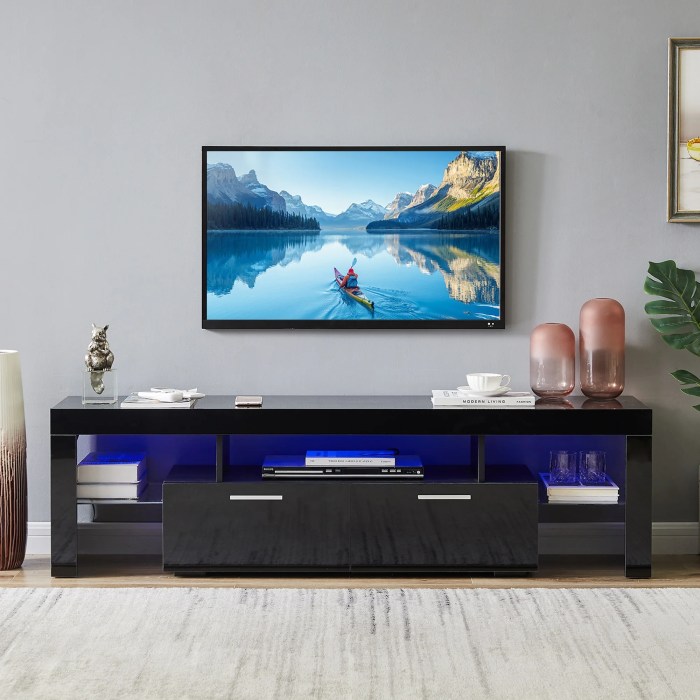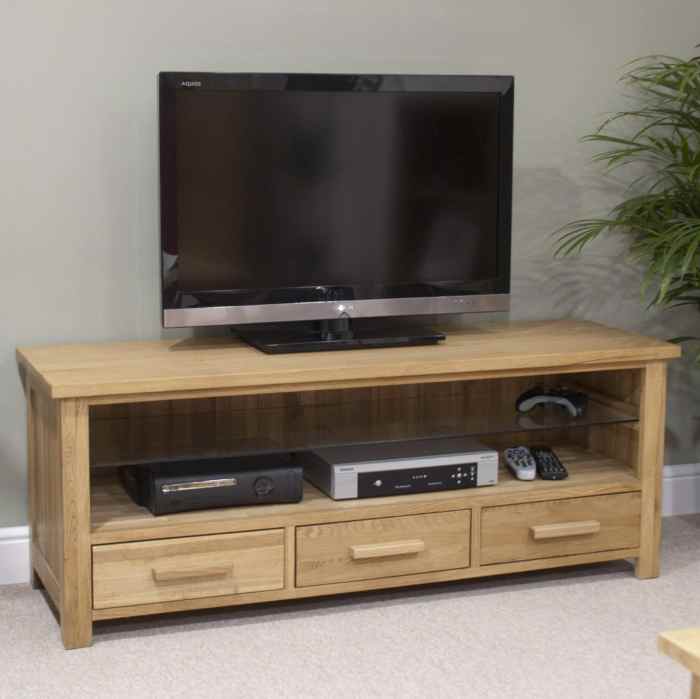TV stand furniture offers more than just a place to rest your television; it’s a statement piece that anchors your living room’s design. From sleek modern designs to rustic farmhouse styles, the options are vast, allowing you to seamlessly integrate functionality and aesthetics into your home entertainment setup. Choosing the right TV stand involves considering factors like size, storage needs, and overall style to complement your existing décor.
The market offers a wide array of materials, from durable wood and elegant glass to space-saving designs and media consoles with integrated sound systems. Understanding these options empowers you to make an informed decision that enhances both the visual appeal and functionality of your living space. Careful consideration of placement, considering factors such as cable management and accessibility, is crucial for optimal viewing and enjoyment.
Finding the ideal TV stand can significantly enhance your home theater experience and overall living space aesthetics. More than just a place to rest your television, a TV stand serves as a central focal point, influencing the ambiance and functionality of your room. This comprehensive guide will delve into the various aspects of choosing the perfect TV stand, helping you navigate the plethora of options available and make an informed decision.
Understanding Your Needs: Size, Style, and Functionality
Before embarking on your TV stand shopping journey, it’s crucial to assess your specific requirements. Consider the following factors:
TV Size and Weight Capacity:
The most fundamental aspect is ensuring your chosen TV stand can comfortably support the weight and dimensions of your television. Manufacturers typically specify weight limits, so carefully check this before purchasing. Don’t forget to account for any additional equipment you plan to place on the stand, such as a sound bar, gaming consoles, or cable boxes. A larger TV naturally necessitates a more robust and spacious stand.
Room Size and Layout:
The size of your living room or media room will dictate the appropriate dimensions of your TV stand. A massive stand in a small room will overwhelm the space, while a tiny stand in a large room might appear insignificant. Consider the overall flow of your room and how the stand will integrate with your existing furniture. Measure the available space carefully to avoid purchasing a stand that’s too large or too small.
Style and Aesthetics:
TV stands are available in a wide array of styles, from sleek and modern to rustic and traditional. Choose a style that complements your existing décor and personal taste. Consider the materials used – wood, metal, glass, or a combination – and their finish. The color and overall design should seamlessly blend with your room’s aesthetic, enhancing rather than clashing with the existing ambiance.
Popular styles include contemporary, mid-century modern, farmhouse, industrial, and traditional.

Storage and Functionality:
Think about your storage needs. Do you require ample space for media components, gaming consoles, or books? Some TV stands offer closed cabinets for concealing clutter, while others feature open shelving for displaying decorative items. Consider features like cable management systems to keep wires organized and hidden. Drawers, shelves, and cubbies provide different levels of storage solutions.
Types of TV Stands: A Diverse Selection: TV Stand Furniture
The market offers a broad spectrum of TV stand designs, each catering to different needs and preferences:
Traditional TV Stands:
These classic designs often feature solid wood construction, ornate detailing, and ample storage space. They are perfect for traditional or formal living rooms, providing a sense of timeless elegance.
Modern TV Stands:
Characterized by clean lines, minimalist designs, and often incorporating materials like glass and metal, modern TV stands are ideal for contemporary or minimalist interiors. They typically prioritize sleek aesthetics over extensive storage.
Entertainment Centers:, TV stand furniture
These larger units combine a TV stand with extensive storage solutions, often including multiple drawers, cabinets, and shelves. They are perfect for those with a large collection of media and electronics.
Wall-Mounted TV Stands:
These stands are designed to be mounted to the wall, creating a floating effect that saves floor space and can enhance the modern aesthetic of a room. They are particularly suitable for smaller living spaces.
Corner TV Stands:
Specifically designed to fit snugly into corners, these stands maximize space utilization and are a practical choice for rooms with limited floor space. They are particularly versatile for smaller rooms or oddly shaped spaces.
Materials and Construction: Durability and Aesthetics
The material of your TV stand significantly impacts its durability, aesthetic appeal, and longevity:
Wood:
A classic choice, wood offers a natural beauty and warmth. Different wood types, such as oak, cherry, and walnut, offer varying levels of durability and aesthetic qualities. Solid wood is more durable than engineered wood, but also more expensive.
Metal:
Metal TV stands, often constructed from steel or aluminum, offer a modern and industrial aesthetic. They are typically durable and sturdy, but can be prone to scratches and dents.
Glass:
Glass TV stands provide a sleek and contemporary look, but require careful handling to avoid breakage. They are often combined with other materials, such as metal or wood, for added stability and support.
Engineered Wood:
A more affordable alternative to solid wood, engineered wood is made from wood fibers and resins. While less durable than solid wood, it offers a good balance of affordability and aesthetics.

Choosing the Right Size and Placement: Maximizing Your Viewing Experience
Proper placement of your TV stand is essential for optimal viewing and room aesthetics:
Viewing Distance:
The distance between your seating area and the TV should be appropriate for your screen size to ensure comfortable viewing. General guidelines are available online to help determine the ideal viewing distance for different screen sizes. This will influence the placement of your TV stand.
Room Layout:
Consider the placement of other furniture and the overall flow of the room. Avoid placing the TV stand in high-traffic areas or where it might obstruct movement. Ensure there is enough space around the stand for easy access to electronics and other items.
Ambient Lighting:
Minimize glare by avoiding placing the TV stand directly in front of a window or other bright light source. Consider the placement of lamps and other lighting fixtures to optimize viewing conditions.

Frequently Asked Questions (FAQ)
- What is the best type of TV stand for a large TV? A sturdy stand with a high weight capacity and a wide base is recommended for larger TVs. Consider entertainment centers or stands made from solid wood or metal.
- How much should I spend on a TV stand? Prices vary greatly depending on size, material, and features. Set a budget based on your needs and preferences, keeping in mind that higher-quality stands generally last longer.
- How do I choose the right size TV stand for my room? Measure the available space in your room and consider the overall proportions of your furniture. Avoid purchasing a stand that’s too large or too small for the space.
- What are the best materials for a TV stand? Solid wood, metal, and engineered wood are popular choices, each offering different levels of durability and aesthetic appeal.
- How do I organize cables on my TV stand? Use cable ties, cord organizers, or cable management systems to keep wires neatly organized and concealed.
Conclusion: Finding Your Perfect TV Stand
Selecting the right TV stand involves careful consideration of various factors, from size and style to material and functionality. By understanding your needs and preferences, and by researching the diverse options available, you can find the perfect TV stand to enhance both your viewing experience and the aesthetic appeal of your home. Remember to prioritize quality, durability, and a design that complements your existing décor.
References:
- Wayfair (Example – Replace with relevant and credible sources)
- Amazon (Example – Replace with relevant and credible sources)
Call to Action:
Start browsing for your perfect TV stand today! Use the information in this guide to make an informed decision and transform your living space into a stylish and functional entertainment hub.
Commonly Asked Questions
What size TV stand do I need?
Measure your TV’s width and depth, then choose a stand slightly larger to allow for ventilation and prevent the TV from looking cramped.
What materials are best for TV stands?
Wood offers durability and a classic look, while glass provides a modern aesthetic. Metal stands are often sleek and sturdy. Consider your décor and desired level of durability when choosing.
How important is cable management?
Good cable management is essential for a clean and organized look. Look for stands with built-in cable management features or use cable ties to keep things neat.
